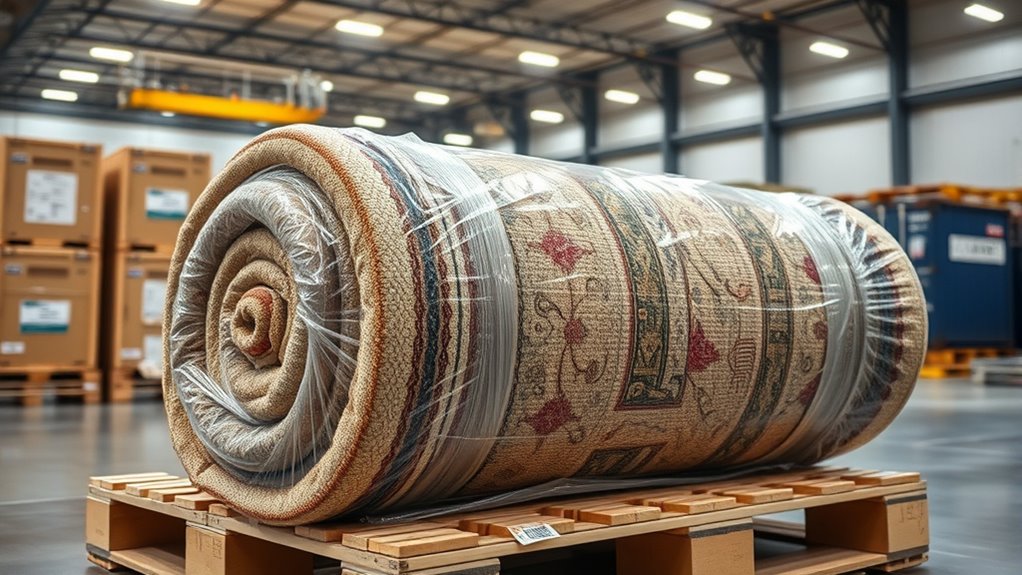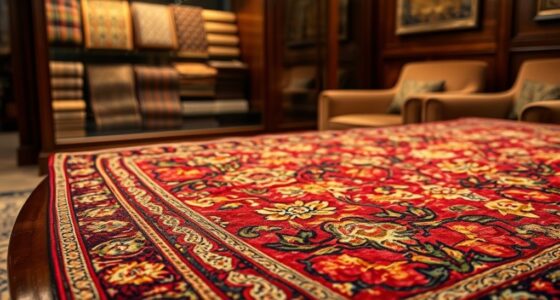To ship rugs internationally, start by thoroughly cleaning and drying your rug to prevent mold. Use protective wrapping like plastic and cushioning materials to safeguard edges and patterns. Opt for rolling the rug to save space and reduce damage. Choose a reputable carrier with tracking and insurance options. Properly declare its value and contents for customs clearance. Proper handling during transit is essential to maintain quality, and you’ll discover more expert tips to ensure safe delivery.
Key Takeaways
- Thoroughly clean, dry, and inspect the rug before packaging to prevent mold, pests, and damage during transit.
- Use protective wraps like plastic and cushioning materials such as bubble wrap to shield against moisture and impact.
- Roll the rug tightly and securely, avoiding folds, then pack in a sturdy box with additional padding if necessary.
- Choose reputable carriers with tracking, insurance, and customs support, ensuring compliance with destination country regulations.
- Inspect the rug upon receipt for damage, document any issues, and handle carefully to maintain quality and avoid further harm.
Selecting the Appropriate Packaging Materials
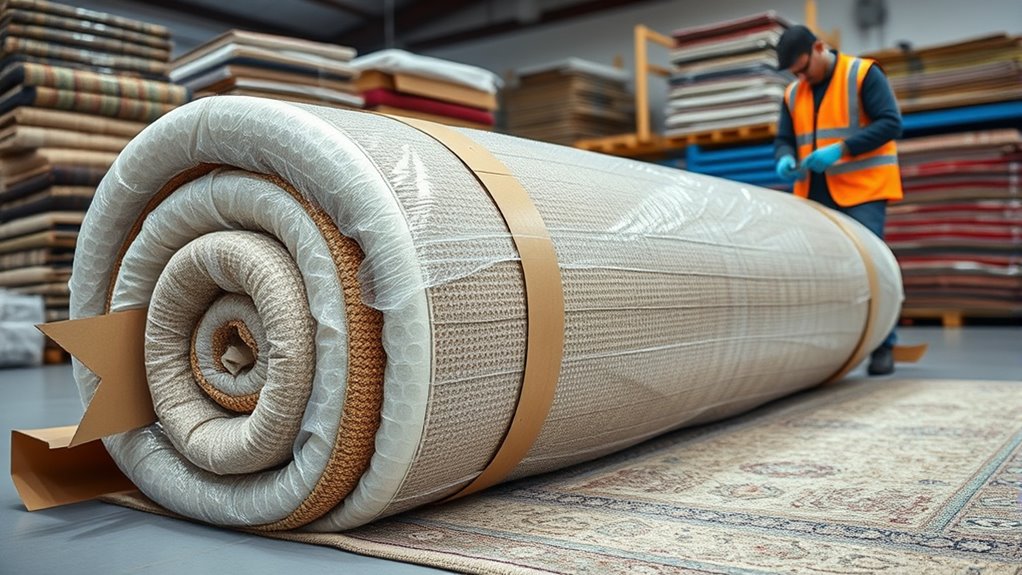
Choosing the right packaging materials is essential to guarantee your rug arrives safely at its destination. Start with protective wrapping, such as plastic or shrink wrap, to shield the rug from dirt, moisture, and damage during transit. Use cushioning materials like bubble wrap, foam padding, or packing paper to provide extra protection around the rug’s edges and surface. These materials absorb shocks and prevent tears or fraying. Ascertain the entire rug is securely wrapped, avoiding loose sections that could snag or shift. Properly selected packaging not only safeguards your rug but also minimizes the risk of damage during international shipping. Investing in quality protective wrapping and cushioning materials can save you time and money in the long run. Additionally, understanding shipping regulations and proper documentation can help ensure a smooth delivery process.
Properly Cleaning and Preparing Your Rug Before Shipping

Before shipping your rug, you need to clean it thoroughly to remove dirt and pests. Make sure it’s completely dry and free of debris before packing. Properly packing your rug will help protect it during transit and guarantee it arrives in great condition. Incorporating proper handling practices can further ensure the rug remains undamaged throughout the shipping process. Additionally, understanding heat pump technology can aid in selecting appropriate climate control measures for storage or display environments to maintain your rug’s condition. Using self watering plant pots as an analogy, maintaining proper moisture levels during storage can help preserve the rug’s fibers and color. Ensuring optimal air purifier maintenance during storage can also help prevent mold and mustiness that could damage your rug over time. Regularly monitoring dehumidification systems can help control humidity levels and protect your rug from moisture-related damage over extended storage periods.
Deep Clean Thoroughly
Ensuring your rug is thoroughly cleaned before shipping is essential to prevent mold, dirt, and pests from causing damage during transit. Start with a comprehensive rug cleaning to remove surface dust and embedded debris. Focus on stain removal, as lingering stains can attract pests or worsen during travel. Use appropriate cleaning methods based on your rug’s material, guaranteeing all spots and discolorations are addressed. A deep clean not only improves appearance but also boosts the rug’s longevity during shipping. Pay close attention to corners and fringes, which often trap dirt. Once cleaned, allow the rug to dry completely to prevent mold growth. Properly surface sanitation is crucial for maintaining hygiene and protecting your rug’s quality during transit. Additionally, considering material-specific cleaning techniques can help preserve the fibers and colors of your rug. Proper cleaning and thorough drying prevent damage and help ensure your rug arrives in optimal condition. Taking these steps guarantees your rug is in ideal condition for international transit, reducing the risk of damage and ensuring it arrives looking its best. Incorporating professional cleaning services can further enhance your preparation process for long-distance shipping.
Properly Pack Rug
To properly pack your rug for international shipping, start by securing it in a way that prevents damage during transit. First, verify the rug is clean and dry to avoid mold or odors. Proper cleaning and preparation ensure the rug is in optimal condition for shipping. Wrap it with protective wrapping, such as plastic or biodegradable material, to shield it from dirt and moisture. Incorporate moisture barriers, like a plastic sheet or waterproof layer, to keep the rug dry during handling and transit. Roll the rug tightly, securing it with straps or twine to maintain its shape. Avoid folding, which can cause creases. Place the rolled rug in a sturdy, appropriately sized box or crate, adding padding if necessary. Properly wrapping and using moisture barriers will help preserve the rug’s condition throughout its journey. Additionally, understanding cybersecurity best practices can help protect your digital information during the shipping process. Ensuring proper heat pump installation and handling techniques can also prevent damage during transportation. Being aware of international shipping regulations can further streamline the process and avoid unexpected delays or issues. Moreover, researching customs documentation requirements is essential to facilitate smooth clearance at borders.
Rolling vs. Folding: Which Method Is Best?

When choosing between rolling and folding your rug, you’ll want to contemplate space efficiency, as rolling often takes up less room. You should also think about damage risk, since folding can create creases and tears, while rolling minimizes stress on the fibers. Additionally, handling and storage become easier with one method over the other, impacting your shipping process overall. Moreover, considering the security of your shipment, especially for valuable or delicate rugs, can help prevent damage during transit. Properly rolling a rug can also reduce the likelihood of fiber damage, which is crucial for maintaining its quality during long-distance shipping. Incorporating proper packing techniques can further safeguard your rug and ensure it arrives in optimal condition.
Space Efficiency Comparison
Choosing the right method to pack your rugs can substantially impact how much space they take up during shipping. Both rolling and folding have their advantages, but understanding their space efficiency can help optimize packaging size. Rolling typically results in a more compact form, reducing overall volume and making it easier to maximize container space. Folding, while quicker, may create bulkier packages that occupy more room. Consider these points for space saving techniques:
- Rolling minimizes air gaps and compresses the rug more tightly
- Folding may cause creases, increasing packing size
- Rolling reduces the need for excessive wrapping materials
- Folding can be quicker but less space-efficient
Damage Risk Factors
While both rolling and folding are common methods for packing rugs, each carries different risks of damage during transit. Rolling minimizes creases and reduces the chance of moisture absorption, helping keep your rug dry and clean. However, if not rolled tightly, it can develop creases or tears over time. Folding, on the other hand, saves space but creates sharp creases that may weaken fibers or cause permanent damage. Additionally, folding exposes the rug to higher moisture absorption at crease points, increasing the risk of mold or mildew. Both methods can attract pest infestation if not properly protected, especially in humid environments. To minimize damage, ensure rugs are thoroughly cleaned, dry, and wrapped securely, regardless of the packing method you choose.
Handling and Storage
Your choice between rolling and folding your rug for handling and storage directly impacts its safety during transit. Rolling is generally preferred because it reduces creases and minimizes stress on fibers, making it ideal for long-term storage solutions. Folding can create permanent creases and damage the rug’s structure if not done carefully. When storing, ensure proper climate control to prevent mold, mildew, or fading. Proper handling extends your rug’s lifespan and keeps it in pristine condition. Consider these factors:
- Use acid-free paper or breathable fabric to wrap the rug
- Store in a cool, dry, climate-controlled environment
- Avoid placing heavy objects on top
- Regularly inspect for pests or moisture issues
Making informed choices about handling and storage preserves your rug’s beauty and value during international shipping.
Securing the Rug to Prevent Damage During Transit
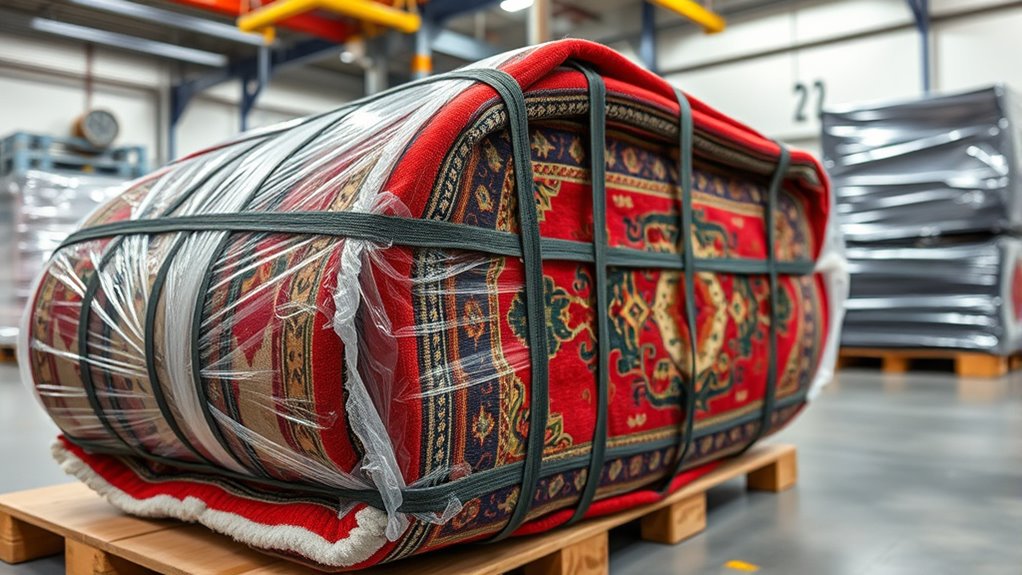
Securing a rug properly is essential to prevent damage during transit, especially when shipping internationally where handling can be rough. Start by protecting the fringe with fringe protection materials like bubble wrap or tissue paper to prevent tangling or fraying. Next, secure the corners by wrapping them tightly with kraft paper or corner protectors to maintain shape and avoid tears. Use plastic or packing tape to hold the wrapping in place without damaging the rug’s fibers. Avoid excessive movement inside the packaging by adding padding, like foam or bubble wrap, around the rug’s edges. Properly securing the corners and fringe ensures the rug remains intact and arrives in pristine condition, reducing the risk of tears, fraying, or other damage during transit.
Choosing the Right Shipping Carrier for International Deliveries
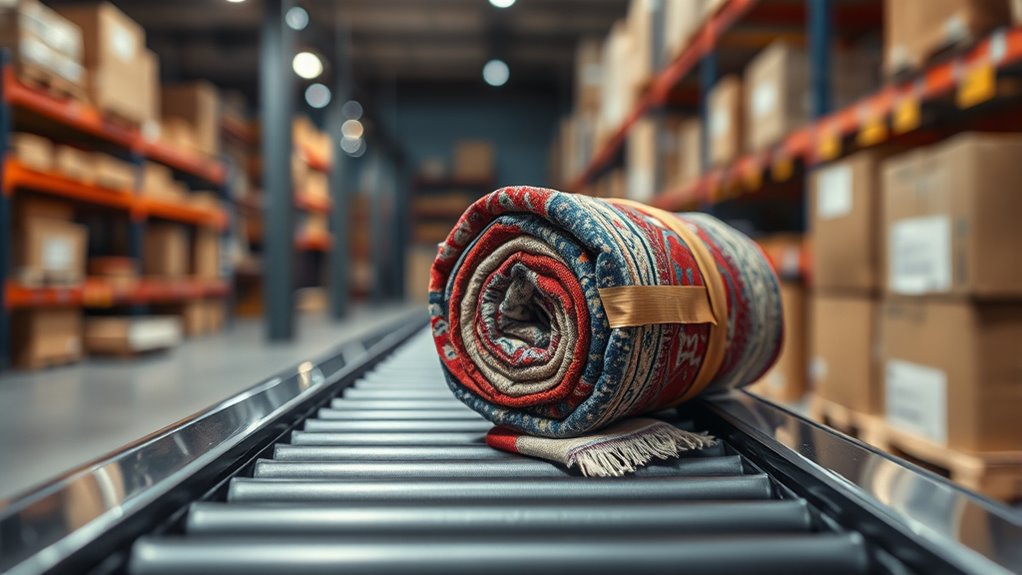
When selecting an international shipping carrier, you need to consider their reputation and reliability to ensure your rug arrives safely. Cost and delivery speed are also key factors that can impact your choice, along with available service options and support. Making an informed decision helps you find the best balance between affordability and quality.
Carrier Reputation and Reliability
Choosing a reliable shipping carrier is essential for ensuring your rug arrives safely and on time. The carrier’s reputation reflects their track record for handling shipments securely, which directly impacts your peace of mind. To avoid reliability issues, research carriers’ past performance, read reviews, and check their complaint history. A carrier with a strong reputation is less likely to encounter delays or mishandling. Keep in mind that even reputable carriers can face occasional reliability issues, so selecting one with excellent customer support and clear procedures is wise.
- Track record of on-time deliveries
- Customer reviews and feedback
- Response to past issues
- Industry reputation and awards
Cost and Delivery Speed
Balancing cost and delivery speed is vital when selecting an international shipping carrier for your rug. You need to evaluate different pricing strategies to find options that fit your budget without sacrificing reliability. Some carriers offer competitive rates but may take longer, while others prioritize quick delivery at a higher cost. Delivery tracking is indispensable, so choose a carrier that provides real-time updates to monitor your shipment’s progress. Consider your timeline and budget carefully—if speed is a priority, opt for express services, even if they cost more. Conversely, if you’re flexible on delivery time, economy options can save money. Ultimately, weighing the trade-offs between pricing strategies and tracking capabilities helps guarantee your rug arrives safely, on time, and within your budget.
Service Options and Support
Service options and support play a key role in ensuring your rug arrives safely and intact. Choosing a carrier with reliable customs paperwork handling and extensive international tracking helps prevent delays and damages. A good carrier will offer options like insurance, expedited shipping, and door-to-door delivery, giving you peace of mind. It’s essential to verify their support services for customs clearance, ensuring your shipment complies with import regulations. Additionally, real-time international tracking allows you to monitor your rug’s journey and address issues promptly. Selecting a carrier with these features helps streamline the process and minimizes surprises, making sure your rug reaches its destination in perfect condition. Keep these factors in mind to choose the best shipping partner for your needs.
Understanding Customs Regulations and Documentation Requirements
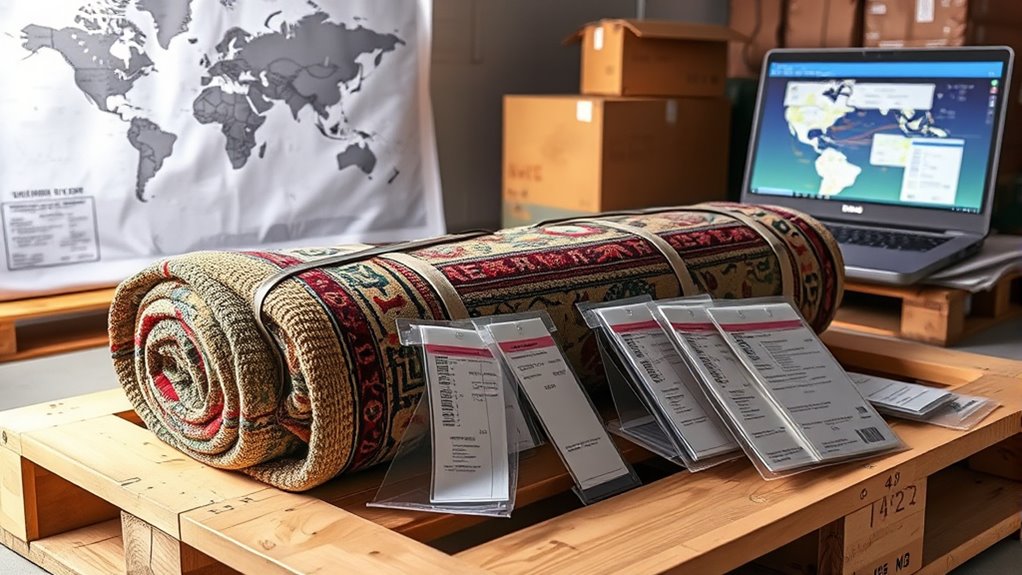
Understanding customs regulations and documentation requirements is crucial when shipping rugs internationally, as these rules vary by destination country and can greatly impact your shipment’s smooth passage. You need to verify proper documentation to facilitate customs clearance, avoiding delays or fines. Essential documents often include commercial invoices, packing lists, and certificates of origin. Each country may have specific forms or certifications required, so research the destination’s customs policies thoroughly. Failing to meet these documentation requirements can lead to shipment holds or rejection. It’s your responsibility to verify all paperwork is accurate, complete, and compliant with local laws. By understanding these regulations upfront, you help ensure your rug clears customs efficiently and reaches its destination without unnecessary obstacles.
Declaring the Correct Value and Content for Customs Clearance
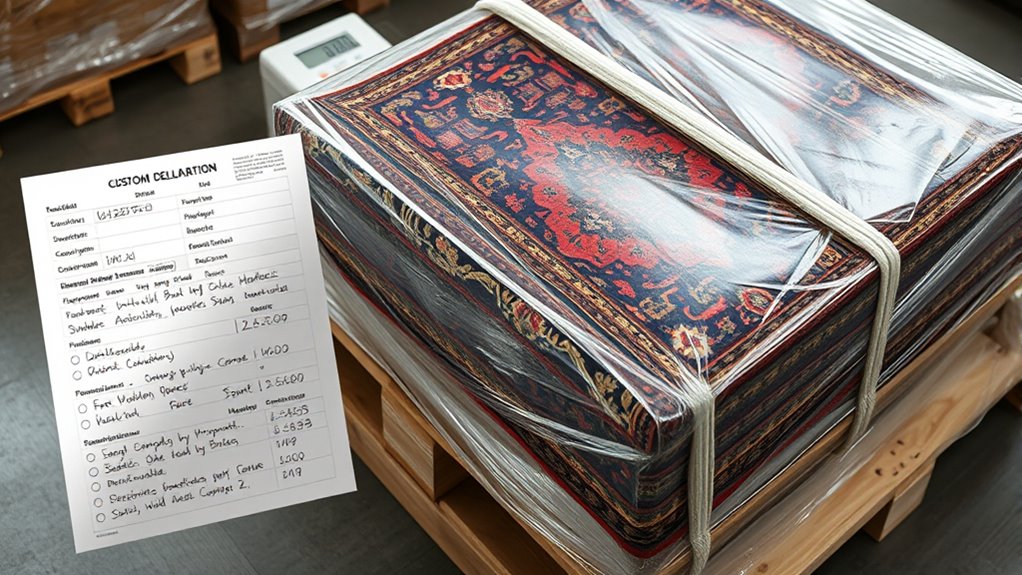
Accurately declaring the value and content of your rugs is essential for smooth customs clearance. A proper customs declaration guarantees your shipment isn’t delayed or fined. Focus on valuation accuracy by honestly listing the worth of your rugs based on current market prices. Incorrect declarations can lead to penalties or confiscation.
To get it right, consider these key points:
- Use precise descriptions of your rugs’ materials and origins
- Declare the true purchase or replacement value
- Avoid under- or over-inflating the declared value
- Attach supporting documentation when necessary
Tracking and Insuring Your Shipment for Peace of Mind
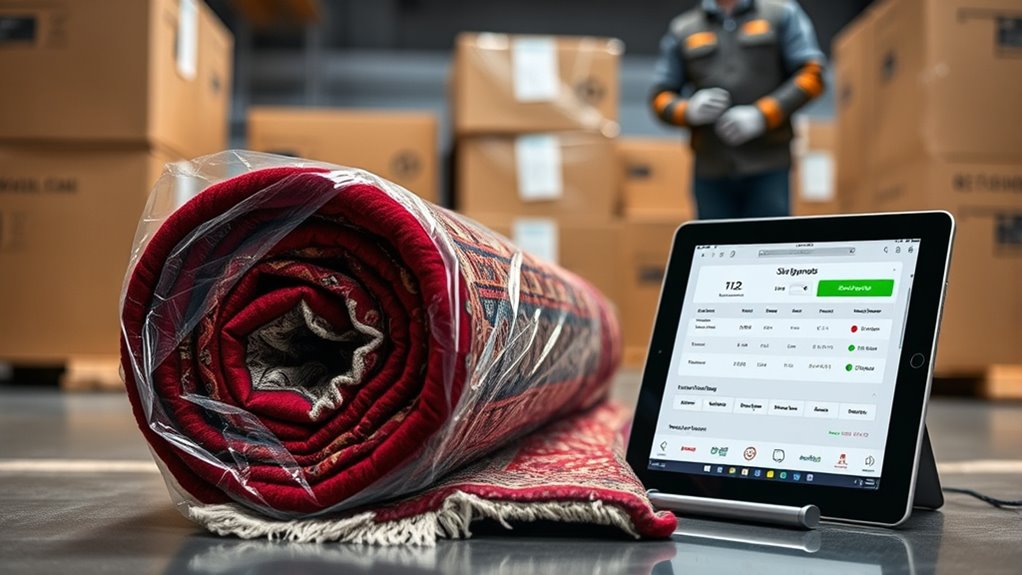
Tracking and safeguarding your shipment guarantees you have visibility and protection throughout the shipping process. Using advanced tracking technology, you can monitor your rug’s location in real-time, reducing stress and ensuring timely delivery. Additionally, securing appropriate insurance coverage shields you from potential losses or damages during transit. It’s essential to choose an insurance plan that covers the full value of your rug, giving you peace of mind. Here’s a quick overview:
| Feature | Benefit |
|---|---|
| Tracking Technology | Real-time updates, enhanced shipment visibility |
| Insurance Coverage | Financial protection against loss or damage |
| Shipment Monitoring | Detect delays or issues early |
| Claim Process | Simple, fast resolution if needed |
Implementing both tracking and insurance ensures your rug arrives safely and with peace of mind.
Handling and Storage Tips During Transit
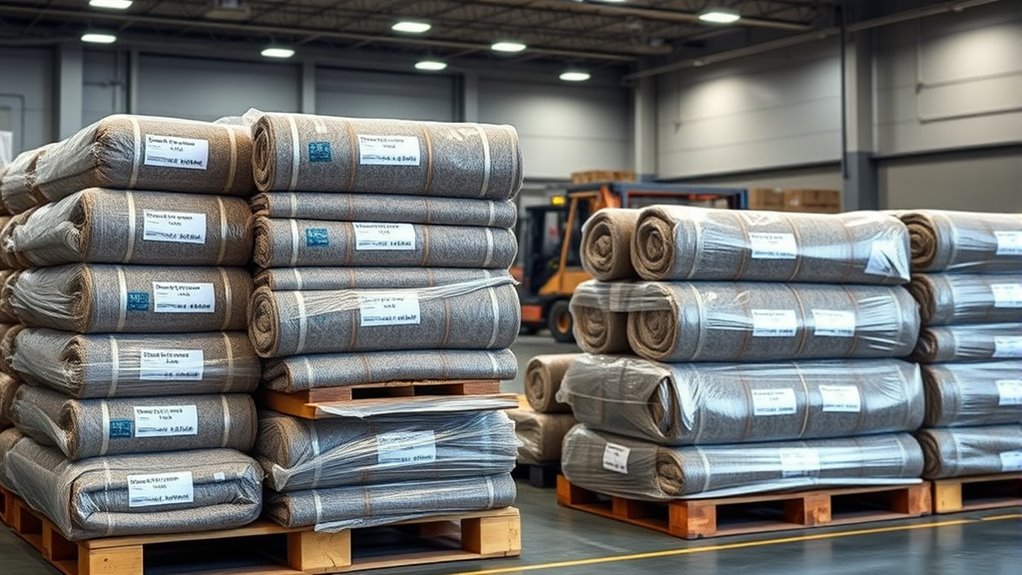
Proper handling and storage during transit are essential to preserving your rug’s condition. Climate considerations, especially humidity control, play a crucial role in preventing mold, mildew, or fiber damage. To ensure your rug stays safe, consider these tips:
Proper handling and climate control are key to preserving your rug during transit.
- Use breathable wrapping materials to allow air circulation.
- Avoid stacking heavy items on top of the rug to prevent distortion.
- Store in a climate-controlled environment if possible, maintaining consistent humidity levels.
- Regularly check for signs of moisture or pests during transit, especially if delays occur.
Tips for Receiving and Unpacking Your Rug Safely Abroad
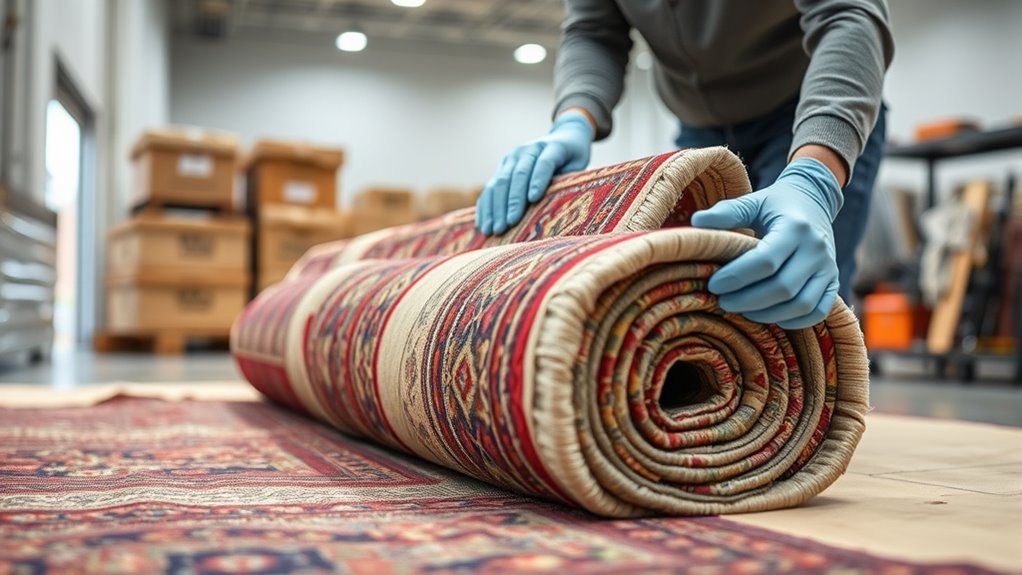
When receiving your rug abroad, it’s important to inspect the package thoroughly before unpacking to guarantee it arrived in good condition. Check for any visible damage to the packaging that might have occurred during transit. Carefully remove the wrapping, avoiding sharp tools that could damage the rug’s fibers or pattern design. As you unroll the rug, examine its color and pattern design for any discoloration or irregularities, which could indicate exposure to moisture or mishandling. Handle the rug gently to prevent stretching or tearing. If you notice any issues, document them immediately and contact the shipping company or seller for resolution. Taking these steps ensures your rug’s vibrant colors and intricate pattern design are preserved and ready to enjoy in your space.
Frequently Asked Questions
How Can I Ensure My Rug Arrives Undamaged Internationally?
To guarantee your rug arrives undamaged internationally, start with sturdy packaging materials like thick plastic wraps and reinforced boxes. Properly cushion the rug to prevent movement during transit. Additionally, secure insurance coverage for the shipment to protect against potential damage or loss. Always choose a reliable carrier with experience in handling fragile items, and clearly label the package as fragile to alert handlers. These steps help safeguard your rug during its journey abroad.
Are There Specific Restrictions for Shipping Antique Rugs Abroad?
Imagine carefully wrapping a delicate antique rug, only to discover hidden antique rug restrictions that could hinder its journey. You need to check vintage rug regulations and antique rug restrictions before shipping abroad. Some countries impose specific import restrictions, require documentation, or ban certain antique textiles. To avoid surprises, research destination country rules and work with experienced shippers who understand international antique shipping laws. This guarantees your precious piece arrives safely and legally.
What Are the Cost Implications of Different Shipping Methods?
When comparing shipping methods, you should consider costs like shipping insurance and customs duties. Air freight is faster but more expensive, often requiring higher insurance and duty fees. Sea freight is cheaper but takes longer, which can reduce overall costs. You’ll need to factor in customs duties based on the rug’s value and destination, and guarantee proper shipping insurance to protect against damage or loss during transit.
How Do I Handle Potential Delays in International Shipments?
When handling potential delays in international shipments, you should stay proactive. Make sure you have all customs documentation in order to avoid hold-ups, and consider purchasing shipping insurance for added protection. Regularly communicate with your carrier for updates, and inform your customer about possible delays. This way, you reduce surprises and maintain trust, ensuring your rug reaches its destination smoothly despite unforeseen issues.
Can I Ship a Rug Directly From a Seller to the Recipient Internationally?
You can ship a rug directly from a seller to an international recipient, but you need to handle customs documentation and shipping insurance carefully. Guarantee all customs forms are accurately completed to prevent delays, and consider insuring the shipment to protect against loss or damage. Clear communication with the seller about shipping details and tracking ensures a smooth delivery. By managing customs and insurance, you make international rug shipping seamless and secure.
Conclusion
Shipping your rug internationally is like guiding a delicate butterfly across the globe—you need the right tools and care to guarantee it arrives safely. By choosing proper packaging, selecting trusted carriers, and understanding customs, you’re setting the stage for a smooth journey. Stay vigilant with tracking and insurance, and handle your rug with the same gentle touch you’d give a treasured keepsake. With these best practices, your rug’s voyage will be as graceful as its destination.
